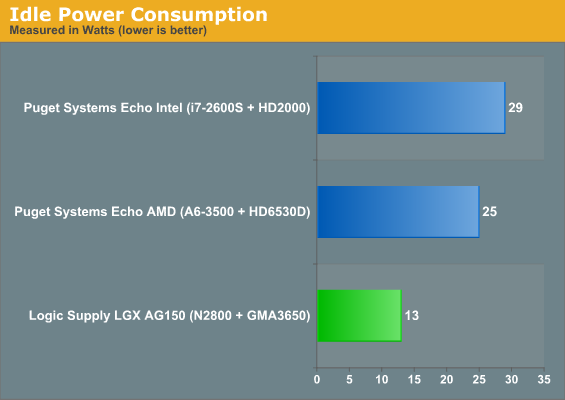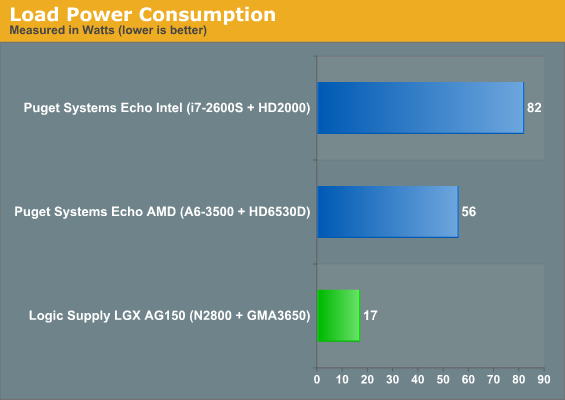Logic Supply LGX AG150 Fanless System Review: Cedar Trail or Cedar Trial?
by Dustin Sklavos on May 28, 2012 11:30 PM EST- Posted in
- kiosk
- Systems
- Atom
- Cedar Trail
User Experience and Power Consumption
Intel's Cedar Trail based Atom N2800 doesn't look completely bad, at least on paper. It offers a decent improvement over last generation's woefully anemic Atoms, and the GPU at least appears to address the major complaints we had with Pine Trail's pitiful GMA 3150. Unfortunately, Intel has had a history of getting their IGPs to perform well in Futuremark benchmarks only to have performance and compatibility fall apart in practical applications, and that history is repeating itself here.
After having used the LGX AG150, I don't have any trouble believing the rumors that Intel has been having serious problems with the PowerVR core behind the GMA 3650. I'm not going to fault Logic Supply for this; if you're going to build a fanless system that can be deployed cheaply and in significant numbers, I think it's hard to do better than what they've achieved here. However, the responsibility for some of the stability issues and/or lack of support should be placed squarely on Intel's shoulders.
The first review unit I received from Logic Supply had serious issues with screen tearing and stuttering even on the desktop, with or without Aero Glass enabled. When I checked for updated drivers and found them, the updated drivers essentially locked up the system and prevented me from re-entering Windows. Rather than have me go through the trouble of reformatting and trying to get Intel's drivers to work, Logic Supply simply sent me a second review unit that had the new GMA 3650 drivers slipstreamed into the Windows installation. Just think about how bad the situation would have to be to produce a paragraph like this one; the GMA 3650 drivers were incapable of handling a blank desktop. It didn't matter if I changed the resolution or reduced Aero Glass, it just wasn't happening.
The updated drivers fixed the situation...sort of. The GMA 3650 can now run Aero Glass at 1080p, but extremely slowly. Trying to move windows or even do anything results in a tremendous amount of lag in the system. Understanding Atom tends to be confined to the Aero-free Windows 7 Starter, it must be noted that the last generation of Atom processors was actually able to handle Aero Glass just fine. Circumstances are dire when Aero Glass gives your graphics solution problems.
What about H.264 support? Jarred took a quick look at an N2600-based netbook from ASUS here, but the bottom line is that while DXVA support is mostly in place, high definition playback from YouTube, Hulu, or Netflix is still largely out of the question. In 2012, when smartphones and tablets are able to handle most of these tasks, that's just not acceptable.
Most of these factors are beyond the control of Logic Supply, but thankfully the ones that are within Logic Supply's power are handled well: power consumption and thermals. Logic Supply advertises the system with a TDP of just 15 watts, and while our results weren't quite that low, they were still pretty good.


Idle consumption has come down tremendously on most modern processors, but a 32nm Atom still doesn't ask for much when it's not doing much. Load power does break the 15-watt TDP that Logic Supply advertises, but only by two watts, certainly still reasonable—plus, if Logic Supply isn't accounting for PSU efficiency, that would easily explain the extra 2W. Thermals for the system are also excellent; the RAM ran at a nearly consistent 50C, while the CPU cores never really broke 45C under sustained load. And of course, since the system is completely fanless and has no moving parts, meaning it also produces no noise.


_thumb.jpg)
_thumb.jpg)
_thumb.jpg)








46 Comments
View All Comments
KZ0 - Tuesday, May 29, 2012 - link
Last page: "Atom wasn't integrated enough and small enough to actually make it into retail smartphones; no with Medfield it is, but at the same time that sort of design just isn't fast enough for Windows products."supposed to be " ... now, with Medfield, ... "?
Denithor - Tuesday, May 29, 2012 - link
And another one, fourth paragraph on the last page:The word should be 'crux' not 'crus' (which isn't even a word). Spell check should have caught this one...
JarredWalton - Tuesday, May 29, 2012 - link
Unfortunately, this was some information I added to Dustin's review in our CMS, which doesn't really have spellcheck in place. Thanks for the catch; the offending typos have been fixed.eanazag - Tuesday, May 29, 2012 - link
We should not be surprised that Intel cannot get a GPU to function correctly on a part that they make less money on than their main parts. When the last 3 generations of Intel IGPs have been additionally handicapped by their software. I have an Core i3 540, which processor side I am very happy with, but on the graphics side I feel like I should have went a different route for.In x86 this is where we are left. We can do the old desktop model and buy an Intel processor with a discrete graphics card and not compromise. Otherwise we are buying a compromise in either direction with Intel and AMD.
I am still perturbed Intel did not license x86 to nVidia. I think things would look a lot different today if Intel didn't try to squeeze nVidia out of as much as they could. Think Ion and chipsets. I really think AMD would be doing better if they didn't do the same thing in chipsets to nVidia. I really don't think there would be serious competition to Apple in the tablet space if Intel would have granted an x86 license to nVidia. Would there be other ARM choices? Yes. But no one would be as successful as pushing a gaming platform as nVidia is with Tegra/Android ecosystem if Android was left to do it on their own.
I really want to commend nVidia on staying relevant. I really thought their ship was going to sink when AMD and Intel kept finding ways to relegate nVidia to only discrete cards.
JarredWalton - Tuesday, May 29, 2012 - link
I disagree on several points with your idea that NVIDIA would somehow make a better x86 CPU than AMD or Intel, and that they could also get all the chipset stuff right. NVIDIA chipsets ranged from decent with a few minor quirks to downright awful at times. I think NVIDIA pulled out of the AMD chipset business voluntarily when they decided they couldn't offer better quality for less money. On the Intel side, they could have continued to offer something, but I'm convinced we're better off with SLI on Intel chipsets rather than NVIDIA locking SLI use to their own chipsets.Dustin Sklavos - Wednesday, May 30, 2012 - link
On that I actually disagree. It's true their chipset business was a little "eh," but nForce 2 was a stone cold killer back in the Socket A days.Lothsahn - Tuesday, May 29, 2012 - link
I work with Logic Supply for the enterprise, and they're great. They have excellent communication, solid products (we've had little to no RMA's), and excellent support and customer service. When we did have an issue, they had a person in-house reproduce our issue and solve the problem within a day.Compared to working with other sellers (like Dell), it's a world of difference. They make solid products at slightly higher prices, but you get what you pay for.
We've actually been using a very similar product for 2 years, based off the NF96FL mainboard. While our system isn't quite fanless, Logic supply recommended a specific set of fans that are high reliability, and we haven't had a single failure (>40 deployed systems).
bernstein - Tuesday, May 29, 2012 - link
whats really interesting woud be a comparison with amds atom counterpart e-350, especially in those 3dmarks...aduncanvickery - Tuesday, May 29, 2012 - link
I would be interested to see what the Linux performance and support is like for this system. I know a lot of retail outlets use slightly-customized small linux distros for their in-store browsing and internet catalog kiosks. Any thoughts?Lothsahn - Tuesday, May 29, 2012 - link
The PowerVR driver is a mess in linux. Search for "poulsbo linux", and you'll see a lot of information about that. That means the graphics driver problem is likely a huge issue in this model.OTOH, we've been using Ubuntu 10.04 on the NF96FL mainboard (Atom D525) and we haven't had any stability issues at all. We've had ~40 systems deployed, and to my knowledge, haven't had a single crash.